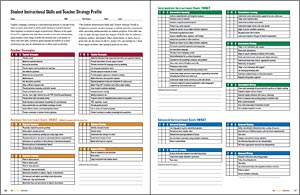Reach & Teach English Language Learners
Help students express their ideas and build vocabulary, and move from beginner to advanced levels of acquisition.

English Language Learning is a developmental process. It can take up to seven years for an ELL to reach native proficiency, as they proceed through three identifiable levels. Each stage of English language acquisition presents unique challenges and requires unique strategies to ensure students progress and develop native proficiency.
Approaching these stages in the most authentic and natural ways possible will be most helpful in your classroom. A parent would not expect their child to learn to speak by writing “Daddy” on a whiteboard. Infants learn words in context, seeing, hearing, and even smelling the object that corresponds to this new word. Similarly, allowing ELL students to acquire new vocabulary in context will aid them in their progression toward English mastery.
Supporting English Language Learners Through All Levels
Pixie provides many ways for students to use words in context, express their ideas, build vocabulary, follow directions, and practice using words and their proper meaning, helping them move from beginner to advanced levels of acquisition.

Beginner
A beginner ranges from the newcomer, or low–beginner, who is adjusting to a new environment, to a high–beginner who has already acquired Basic Interpersonal Communication Skills (BICS) or social language. Even though the newcomer may not yet be speaking English, they are exposed to the second language from day one.
Focusing on language arts and thematic teaching during the beginning stages is most helpful. This provides opportunities to repeat the same words in context. Using visuals to develop vocabulary is of the utmost importance. Combining Pixie’s paint tools with its extensive image library can help students build new vocabulary, allowing them to communicate understanding without worrying about a new language.
Low-Beginner
Engaging a newcomer can be difficult. Limited understanding of the new language makes them very reliant on their visual strengths and the kindness of those around them. The low-beginner:
- Responds nonverbally.
- Depends on gestures and facial expressions and uses visuals.
- Relies on translators.
- Begins to repeat language, using one word or short phrases.
Strategies:
- Provide visuals and use gestures to communicate.
- Use daily routines in the classroom.
- Have students act as buddies.
- Repeat the same activity, lesson, or vocabulary in different ways.
- Allow sufficient response time.
How Pixie can help:
At this stage, Pixie can help you communicate and differentiate by providing tools you can use to create talking pictures to develop and reinforce vocabulary. Have students use the talking pictures you develop, both independently and with buddies, to reinforce learning while the rest of the class is involved in other activities. Depending on their background and grade level, you may also want to show your ELLs how to launch Pixie and open a talking picture on their own. If you do not have a computer for each student, use the Print options to create handouts.
- Create talking pictures to pinpoint key classroom vocabulary like supplies and routines. Use photographs of specific objects whenever available.
- Begin creating a word bank file in Pixie that students can access on their own. Record your voice, or student voices, to name the pictures.
- Add photos of your students to Pixie to create a “My Class” visual seating chart, including text objects with student names.
- Use the stickers to develop vocabulary. For example, invite students to use weather and holiday stickers to create a thematic picture about winter.
- Show your ELLs how to use the paint tools and stickers in Pixie to create their own pictures. Visuals are helpful to low–beginner ELLs. All students seem able to master the Pixie interface, regardless of their first language.
- Pixie runs in English, Spanish, and French. Change Pixie into a student’s language to help you create a matching game for general vocabulary. Or use the Notebook activity to collect vocabulary for older students.
Mid–Beginner:
The mid-beginner ELL has made some adjustments to his or her new environment. However, communicating with peers and teachers remains frustrating. The mid-beginner:
- Has acquired a social vocabulary of about 500 words.
- Begins to respond with a few words or short phrases.
- Continues to use and need gestures and expressions to communicate.
- May write words or short phrases.
Strategies:
Use the following strategies, along with those you’ve been using for the low-beginner ELL, to engage mid-beginners:
- When asking questions, offer visuals and word choices.
- Provide opportunities for individual, paired, and group work. Include tasks that appeal to a range of learners, like creating charts, drawing, gathering information, and presenting.
- Continue to develop vocabulary thematically.
How Pixie can help:
- Pair a native language speaker with an ELL to create a picture in Pixie with dialogue or a dialogue journal. Have the students use stickers, write, and record short sentences to create a dialogue.
- Have students work in cooperative groups on Pixie projects such as mapping. The ELL can find illustrations, and the native speakers can record the vocabulary and explanations.
- Pixie includes an abundance of math manipulative materials. Use the stickers as virtual manipulatives to have students learn about number operations, money, and create story problems. They can also use number activities and stickers to practice computation and number skills.
- Use the tools in Pixie to create stories for your students. Record your voice on each picture to provide the expression needed for understanding.
- Use Pixie to create an Alphabet Book as you begin teaching letters and letter sounds. Have students choose stickers that show the initial sound for each letter and record narration for each page.
- Have students use the Pixie Sentence Strip activity to begin to write and illustrate short phrases and, as the students advance, simple sentences.
- Use the Five Senses activities to teach about the senses, helping students learn new vocabulary in context. There are enough Pixie activities on this topic to teach, repeat, and assess learning.
High–Beginner:
The high-beginner ELL has developed a solid social vocabulary. While he or she may appear to show more interest in learning, academic vocabulary remains challenging. This stage may last up to two years before the student is ready to develop and use academic vocabulary. Learning a language and learning in a language require different levels of acquisition. The high–beginner:
- Has acquired 1,500–2,000 words.
- Speaks and responds in short phrases and may include grammatically incorrect sentences.
- Can be unresponsive at times.
Strategies:
Add these strategies to those described above, especially once you begin to introduce more academic vocabulary.
- Provide graphic organizers.
- Provide sentence starters.
- Model language during a discussion.
How Pixie can help:
At this stage, there are no limits to the ways you can use Pixie to enrich the vocabulary development of the ELL as well as enrich the learning of the native speakers in your classroom. Differentiation enables your teaching to connect with more of your students. One way to differentiate a lesson to reach more learners is to provide choices for how a project can be completed. For example, you might suggest students use a variety of graphic organizers in the Language Arts activity folders when retelling stories.
- Begin a lesson with the KWL chart to activate prior knowledge.
- Have two learners use a Venn diagram to compare two versions of the same story.
- Have the students use the Storyboard activity write an original story.

Intermediate:
The intermediate ELL is becoming much more responsible for their own learning. This stage can last between one to three years before the ELL moves closer to peer-level proficiency. The intermediate ELL:
- Understands more conversations, including some with academic language.
- Can retell a story.
- Asks questions for a purpose. For example, “How do you use the stickers in Pixie?”
- Sometimes gives up if he or she is not understood.
- Begins to write independently.
Strategies:
Add these strategies to the ones you have been using for the beginner ELL:
- Provide guided practice.
- Ask questions that encourage descriptive language responses.
- Help students link new and familiar meanings of words.
- Use modeling to correct language errors.
- Introduce academic vocabulary and develop academic glossaries.
How Pixie can help:
Teachers and students can use the tools and features in Pixie to build vocabulary. Students can use the graphic organizers and activities for self expression and to share knowledge.
- Begin and then end a lesson with the Anticipation Guide activity.
- Use the KWHL chart for questioning and follow-up.
- Use the template to customize your own T-chart activities.
- Have student retell a story with both text and stickers using the Flow Chart activity.
Advanced:
The advanced ELL is nearing grade-level expectations, and you will see more rapid learning. While an ELL student at this stage has acquired an expressive vocabulary of 3,000–4,000 words, remember that their peers generally have a significantly larger working English vocabulary. An average fifth grader, for example, has a working vocabulary of about 10,000 words.
While reading and writing comprehension is stronger, the demands of grade level academics will remain challenging for one to three more years. Now is the time to infuse activities with higher-level thinking skills, such as comparing, evaluating, extrapolating, and synthesizing. The advanced ELL:
- Speaks more fluently and with fewer errors.
- Understands and can respond to social and academic conversations and learning activities.
- Writes independently.
- May be reading and writing one to two years below grade-level expectations.
- May still have difficulty with idiomatic and idiosyncratic language.
- Has difficulty retaining academic vocabulary.
Strategies:
All ELL strategies are still appropriate, but you can now employ these techniques in different ways:
- Use visuals to illustrate and reinforce academic vocabulary.
- Provide a variety of texts about the same subject.
- Ask questions that require an opinion, prediction, or inferential answer.
How Pixie can help:
Pixie’s paint tools, stickers, and the option to import additional images is helpful even at this stage, since the ELL’s verbal expression can be misleading when it comes to academics. Graphic organizers of all kinds also continue to support learning for the advanced ELL.
- Use Pixie’s Fact and Opinion, Pros and Cons, and Web organizers to help the ELL express ideas in a non-threatening way.
- Use clusters to help students build vocabulary, develop the lexicon of a word, and remember academic language.
- Use timelines to help students remember historical facts. Timelines also help students build a cognitive net for keeping track of events, chapter by chapter, when reading longer stories.














